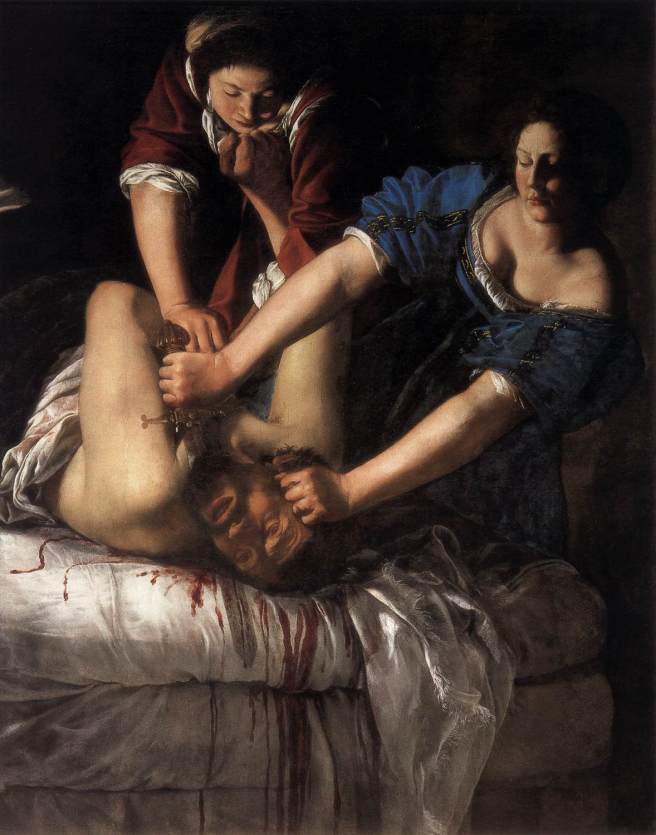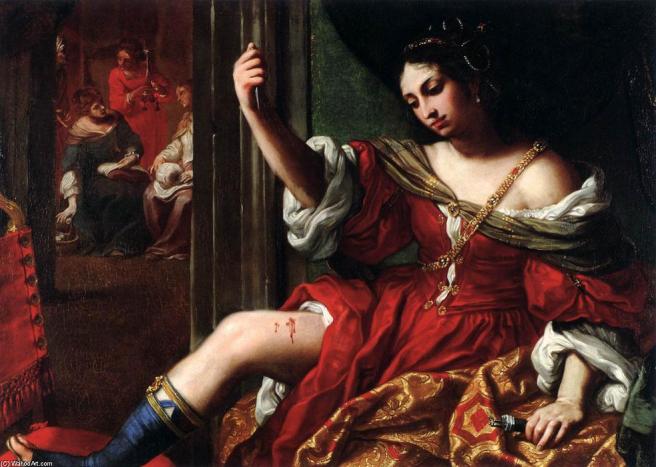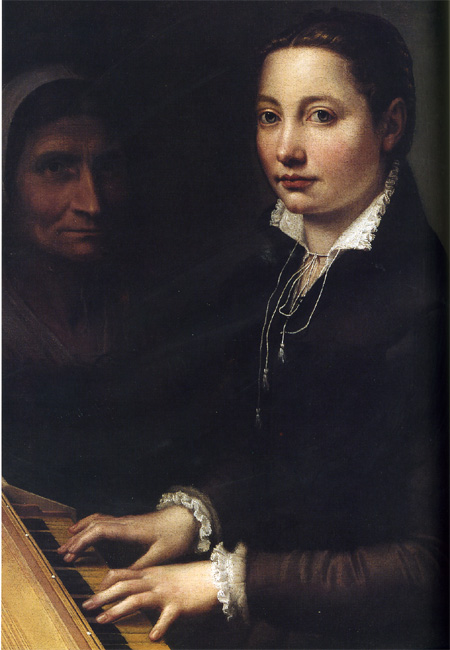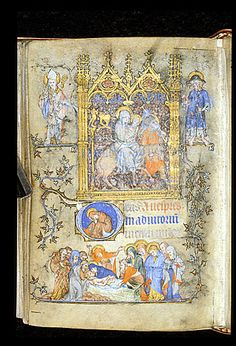 The main formalistic quality to address in this piece is the strong presence of line. There is a very strong diagonal line from the top right corner of the piece, that follows the Judith figure down her arms, specifically her left, down to the head of Holofernes, and continues through the natural way the viewer would follow the slain Holofernes’ gaze. The second strong presence of line is a vertical one. It begins at the face of the second woman figure in the piece, presumably her maid, continues down the center of the piece through Holofernes’ extended arm, continues through his face by using his natural hair line as a literal line, and continues to the bottom until the piece ends using the natural lines of the dripping blood. Another very prominent quality to address is the use of texture in this piece. The texture is most notably seen in the way that Gentileschi portrays fabric. The textile on the mat in which Holofernes’ lays appears light, soft, thin, slightly reflective, and tasseled at the end. Although the same color, this fabric is distinctly different in texture than the fabric that wraps around Holofernes’ body. That fabric is thicker and appears to rest on the body differently. Again, the texture on that particular textile is different from that of the two women. The woman on the left, the maid, represents the thicker garment, there is a quality of smoothness in the texture. This is different from the garment that the woman on the right, Judith, is wearing. The folds on the fabric and the little white undergarment that appears along the chest are distinctly different textures, the blue is made to appear denser and heavier, while the texture that comes from the white fabric is opposite in tis lightness and folds that show thinness.
The main formalistic quality to address in this piece is the strong presence of line. There is a very strong diagonal line from the top right corner of the piece, that follows the Judith figure down her arms, specifically her left, down to the head of Holofernes, and continues through the natural way the viewer would follow the slain Holofernes’ gaze. The second strong presence of line is a vertical one. It begins at the face of the second woman figure in the piece, presumably her maid, continues down the center of the piece through Holofernes’ extended arm, continues through his face by using his natural hair line as a literal line, and continues to the bottom until the piece ends using the natural lines of the dripping blood. Another very prominent quality to address is the use of texture in this piece. The texture is most notably seen in the way that Gentileschi portrays fabric. The textile on the mat in which Holofernes’ lays appears light, soft, thin, slightly reflective, and tasseled at the end. Although the same color, this fabric is distinctly different in texture than the fabric that wraps around Holofernes’ body. That fabric is thicker and appears to rest on the body differently. Again, the texture on that particular textile is different from that of the two women. The woman on the left, the maid, represents the thicker garment, there is a quality of smoothness in the texture. This is different from the garment that the woman on the right, Judith, is wearing. The folds on the fabric and the little white undergarment that appears along the chest are distinctly different textures, the blue is made to appear denser and heavier, while the texture that comes from the white fabric is opposite in tis lightness and folds that show thinness.
Month: February 2017
Elisabetta Sirani, Portia Wounding her Thigh, 1664

This piece features a woman in the foreground, holding a sharp object in her hand. There are a group of three women in the background, barely visible through an open door in the piece. The color that is predominately present in this piece is red. Red is predominant in the foreground due to the fact that it is the color of the woman in the foreground’s dress. Her lips and her cheeks are hued red as well, and she appears to be resting on a gold and red fabric. Her leg is exposed to the viewer, resting on a red chair, and exhibits red blood wounds. Finally, red is present in the three figures in the background of the piece, mainly through the garments of the woman in the center of the three in the background. There is also the strong presence of lines in this piece. There is an article of clothing, resembling a belt that creates a diagonal line across the woman in the foreground’s chest, and the line continues down her exposed leg on the chair. This diagonal line is countered by another diagonal line in the opposite direction, which was caused by the way in which the woman in the foreground has her head tilted, and proceeds to follow the line down the body. However, arguably the strongest presence of line in the piece is a vertical line, starting at the very tip of the woman in the foreground’s right hand, following the sharp object she holds in her hand, and then through a literal direct line present in the piece caused by a curtain or a door frame creates a linear connection from the end of the sharp object to the blood on her leg. Finally, there is a significant presence of texture that can be seen in the way in which the textiles in the piece are painted. There are different textures and tones between the fabric in which she is resting on, the fabric on her clothing, and the texture of the chair.
Sofonisba Anguissola, Self Portrait 1561

The formal aspects of this piece are steeped in its subject as a self-portrait. There are two figures present in this piece. The first is the main subject who is in the light of the piece and is in the fullest view and figure. The second is the older woman in the background; only her face is discernable through the darkness. As the main figure gazes at the viewer through the canvas, indiscreetly and in the light and eye of the viewer, the older woman in the background is made much darker in the background and although she as well holds a gaze with the viewer, she does not hold as much light and emphasis in the piece. The rectangular aspect of this piece adds much to the presence of the idea of the line. There is the line that comes from the stiffness of the main subject’s appearance, and an almost literal line that emerges in the particular spot in the piece where the light abruptly vanishes into dark. There is also the presence of slight horizontal lines, coming from the way in which the piano is positioned in the piece and the direction in which the eye will naturally follow the gaze of the old woman in the background. The colors in this piece are dark and muted, the only breaking of the darkness comes from the colors of the main subject’s skin. The brightness of the piano and of her hands is mirrored across the aforementioned diagonal line in the brightness of the main subject’s face and dress collar. Finally, there are great elements of texture present in this piece; there is a distinct difference in texture in the skin tones and levels of softness of the faces of the two women. Also, there can be seen a distinct difference in the texture of the piano, made to look like wood, and the main subject’s hands, made to look soft, warm, and light.
Bourgot and le Noir: Book of Hours, Flight to Egypt

The most basic elements of form in this piece stem from the fact that the illumination is set on parchment paper, meant to be in a book of hours. There are two distinct scenes, one at the top center of the piece, an illustration of the flight to Egypt, and one at the bottom of the piece, an illustration of the deposition of Jesus. There are also three figures beyond the ones present in the illustrated scenes, two on either side of the Flight to Egypt illustration, and one in the middle of the illuminated “O.” There is a gold leaf decorative pattern around the illustration of the flight to Egypt, and there is the presence of a branch in what otherwise would have been dead space in the piece. In between the top illustration and the bottom illustration there are three lines of text. Of the colors present, the most dominant one is the blue. The blue is found in several figures in the bottom deposition scene, across the crowd of people. The blue also plays a predominant role in the illuminated text, there are various shades of blue in the illuminated “O” from the background to the actual coloring in of the blue text. The two figures on either side of the flight to Egypt scene are also colored blue, and the figure of Mary is in blue against a blue background. The other most notable part of this piece is the gold leaf paint, which highlights the flight to Egypt scene. Gold leaf is also present in lesser distinction in some of the details of the lower deposition scene. The presence of lines in this piece are seen strongest in the visual line that occurs on the left side of the gold leaf frame, it travels down through the illuminated “O,” and ends at the line caused by Mary holding Jesus’ face.